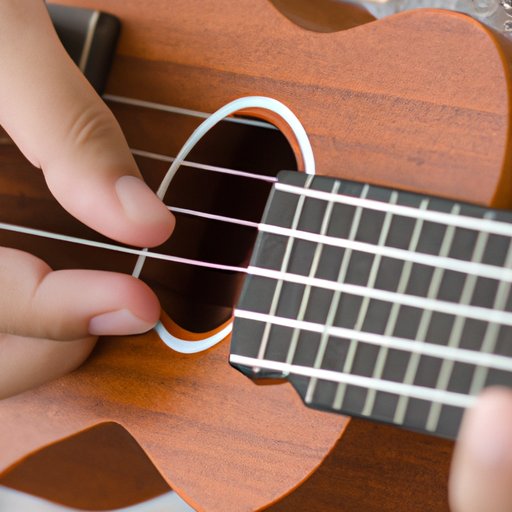
I. Introduction
Are you looking for a fun, portable, and relatively easy instrument to learn? Look no further than the ukulele! This small, four-string instrument has been gaining popularity in recent years, thanks to its unique sound and versatility. In this comprehensive guide, we will provide step-by-step instructions on how to play the ukulele, explore its benefits, fingerpicking techniques, choosing the right instrument, history, and suggest popular songs to learn.
II. A Step-by-Step Guide to Playing the Ukulele for Beginners
Before we dive into chord progressions and strumming techniques, let’s start with the basics of the ukulele. The ukulele has four strings, typically tuned to G, C, E, and A. The body of the ukulele is made of wood, with a fretboard and strings that run down its neck.
When it comes to holding your ukulele, posture is important. Keep your back straight, and rest the body of the ukulele on your thigh. Use your forearm to hold the lower part of the ukulele, and use your fretting hand to hold the neck of the instrument.
The first step to playing your ukulele is tuning it. A good tuner is essential for this step. Many downloadable apps or online tuners can help you tune your ukulele. Once tuned, you can start learning some basic chords. Start with easy chords like C, G, and F, and move on to more complex ones such as A minor and E minor.
Once you’ve learned some chords, practice switching between them fluidly. You can start with a simple strumming pattern, such as down, down, up, up, down, up, and accompany it with a simple chord progression. You can find chord charts online or use a songbook to help you get started.
Hone your skills by practicing frequently. Some popular songs for beginners include “Riptide” by Vance Joy, “I’m Yours” by Jason Mraz, or “Somewhere Over the Rainbow” by Israel Kamakawiwo’ole.
III. The Benefits of Playing the Ukulele
Playing the ukulele provides many benefits aside from the joy of making music. Studies show that playing an instrument can improve cognitive function, lower stress and anxiety, and enhance overall wellbeing. The ukulele’s upbeat rhythms and happy sound make it a mood-booster.
Ukuleles are also incredibly social instruments. Joining a ukulele group or taking lessons with others can be a great way to make new friends and improve your skills. Famous musicians such as Jake Shimabukuro, James Hill, and Eddie Vedder have brought the ukulele into the spotlight, showing the versatility and range of this small instrument.
IV. Tips for Mastering Fingerpicking on the Ukulele
If you want to take your playing to the next level, try fingerpicking on the ukulele. Fingerpicking can add depth and complexity to your playing, and it’s also a lot of fun.
To start, place your fingers on the fretboard and position your thumb on the back of the neck. Use your index finger to pluck the A string, your middle finger for the E string, your ring finger for the C string, and your pinky for the G string.
You can practice fingerpicking patterns such as “Travis picking,” where you alternate between bass notes and strumming the higher strings or “Clawhammer,” which involves striking downward with your finger and plucking upwards with your thumbnail. Try practicing fingerpicking on simple songs such as “You Are My Sunshine” or “House of the Rising Sun.”
V. How to Choose the Right Ukulele for You
Choosing the right ukulele can make a significant impact on your playing experience. There are different types of ukuleles, including soprano, concert, tenor, and baritone, each with distinct sound qualities.
First, consider your body type and which size of ukulele is comfortable to hold. Soprano ukuleles are the smallest and most affordable but can be challenging for people with large hands. Concert and tenor ukuleles are more substantial and have a louder, fuller sound.
Lastly, consider your budget. Ukuleles can range from $25 to over $1000. A good ukulele doesn’t have to break the bank, and it’s worth finding one that feels good to play and sounds great.
VI. The History of the Ukulele
The ukulele has a rich history that dates back to the 19th century. The instrument was developed in Hawaii by Portuguese immigrants who brought their small, stringed instruments with them when they arrived to work on the sugarcane plantations.
King Kalakaua, the last king of Hawaii, was a fan of the ukulele and helped popularize it. Ukuleles gained more widespread appeal in the early 20th century with the help of vaudeville performers such as Roy Smeck and comic actor George Formby. Today, the ukulele remains a popular instrument in Hawaii and around the world.
VII. Songs to Learn on the Ukulele
Ready to start playing some popular tunes? Here are some songs that are great for beginners to learn on the ukulele:
- “Riptide” by Vance Joy
- “I’m Yours” by Jason Mraz
- “Somewhere Over the Rainbow” by Israel Kamakawiwo’ole
- “Dream a Little Dream of Me” by the Mamas and the Papas
- “Can’t Help Falling in Love” by Elvis Presley
Start with the basics of these songs and progress as you become more comfortable playing the ukulele.
VIII. Conclusion
Playing the ukulele is a fun and rewarding experience. We hope that this comprehensive guide has provided you with the tools you need to get started and improve your skills. Remember to have fun and keep practicing, and you’ll be playing your favorite tunes in no time.




